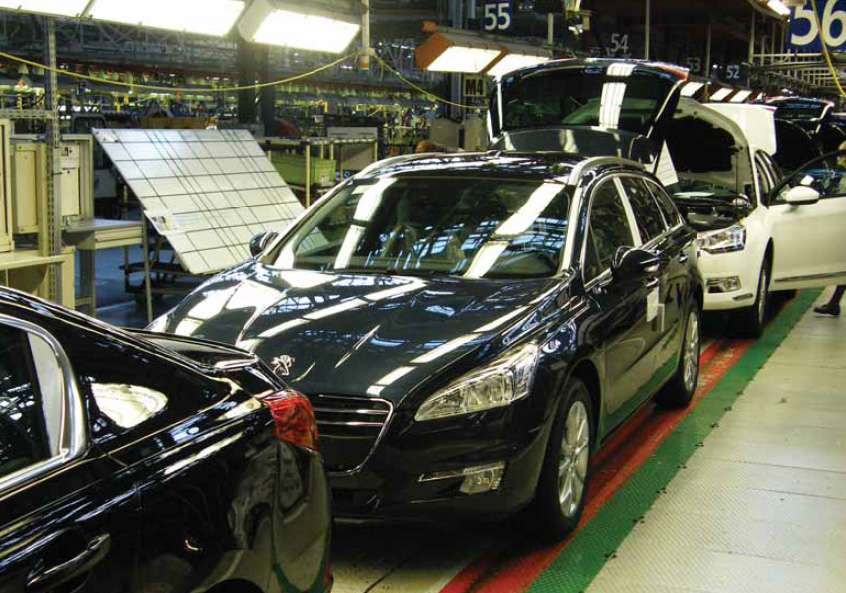
A comprehensive tour of the PSA Rennes plant to find out what processes and technologies were put in place to support production of the new Peugeot 508 range.
Last year the PSA factory in Rennes, France, celebrated its 50th anniversary. Over the half century, the plant has produced a range of different models, the first of which was the Citroën Ami 6. At the time, most plants now considered part of the PSA Group were located around Paris, but a lack of available space at these sites was limiting growth. As such, the carmaker elected to construct a new plant in Rennes, capital of the largely rural Brittany region, both for the available space and to bring jobs to the area.
At its peak, the plant had 10,000 employees; now, about 6,000 people are employed to deliver pressed body and chassis parts that come together across the weld, paint and assembly halls. The majority of panels used in production are pressed at the plant, which also ships parts to other PSA facilities, while a limited number of smaller structural parts are delivered by suppliers. Tooling for the three press lines is also produced in-house. Beyond this, engines and gearboxes used in production are delivered from so-called ‘mécanique et brut’ plants which specialize in powertrain production; as part of this, axles are shipped in from the nearby PSA plant in Caen, Normandy, which produces these parts for all PSA models.
 Since 2000, the group has implemented a strategy whereby individual plants produce vehicles in the same segment for the different brands, which is why today Rennes is manufacturing both the Citroën C5 and the latest addition to its production history, the new Peugeot 508. The 508 saloon and estate models are based on the same chassis as the C5, and the two models also share some sub-assemblies, but across the production process the 508 further benefits from a range of new technologies added to improve build quality, performance and economy.
Since 2000, the group has implemented a strategy whereby individual plants produce vehicles in the same segment for the different brands, which is why today Rennes is manufacturing both the Citroën C5 and the latest addition to its production history, the new Peugeot 508. The 508 saloon and estate models are based on the same chassis as the C5, and the two models also share some sub-assemblies, but across the production process the 508 further benefits from a range of new technologies added to improve build quality, performance and economy.
Shifts and press
According to Loïc Taupin, who is responsible for external communications at PSA Rennes, the press shop operates over three shifts, but with unusual timings. “For example, the morning shift is from 05:39 to 13:00 and the afternoon shift is from 13:21 to 20:21. Why is that? This is because under French law workers are entitled to a 21 minute rest period every seven hours. This is French legislation, it’s not from the European Union. Since we’ve gone to a 35-hour week, this is the arrangement.”
Frédéric Mignot, Director of the Press Shop, says that the original press line, installed in 1960, is still in limited operation. In addition to this venerable technology, a new line was added four years ago, while the most recent addition was a three-bed press installed only a year ago specifically for production of the 508. The pressing process starts with steel coil being unwound at the head of the press line in preparation for blanking. The coil, which is delivered by a range of companies that includes ArcelorMittal and ThyssenKrupp, is delivered by truck and rail. To help with unloading and storage, a spur line allows rail wagons to enter the press shop building.
In addition to this venerable technology, a new line was added four years ago, while the most recent addition was a three-bed press installed only a year ago specifically for production of the 508. The pressing process starts with steel coil being unwound at the head of the press line in preparation for blanking. The coil, which is delivered by a range of companies that includes ArcelorMittal and ThyssenKrupp, is delivered by truck and rail. To help with unloading and storage, a spur line allows rail wagons to enter the press shop building.
While primarily a steel body, the 508 also features a limited number of aluminium parts. The material, which is sourced from Pechiney (now part of Rio Tinto Alcan), is cold stamped. “Aluminium has considerable springback between the first and last punch, so we use simulations to establish what the final part will look like,” says Mignot. Walking around the shop, he points out that that workers have custom-fit earplugs in order to prevent hearing damage, as they work through the 750 tonnes of steel coil that is processed by the plant each day.
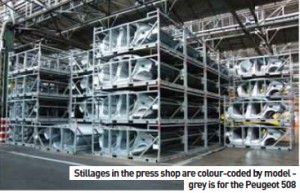 Before the blanks are pressed, the unrolled coil is degreased, largely to aid in picking of the final parts. The blanking machine itself incorporates a ‘dead arm’, a five metre dip in the metal sheet that is designed to absorb the shock of the blanking press before it can translate back to the unrolling coil. Mignon adds that the same type of steel is used for structural and ‘aspect’ or exterior panels, with the only variation being the thickness of the material. He goes on to say that the press shop delivers more than 300 different parts; in 2010, the grand total of pressed pieces exceeded 21 million parts.
Before the blanks are pressed, the unrolled coil is degreased, largely to aid in picking of the final parts. The blanking machine itself incorporates a ‘dead arm’, a five metre dip in the metal sheet that is designed to absorb the shock of the blanking press before it can translate back to the unrolling coil. Mignon adds that the same type of steel is used for structural and ‘aspect’ or exterior panels, with the only variation being the thickness of the material. He goes on to say that the press shop delivers more than 300 different parts; in 2010, the grand total of pressed pieces exceeded 21 million parts.
While the tandem presses use automation to transfer parts down the line, the finished panels are hand picked. “It’s a touch and visual control,” says Mignon. “We check the parts and if there’s a problem [with the part], there’s probably a problem with the tooling.” In addition to this, the press shop has a dedicated metrology room that uses equipment including a LK G90 C point testing machine to validate a random selection of parts for dimensional accuracy. Instead of being sent back with the scrap off-cuts, imperfect parts are retained so that workers can see and learn what defects they could encounter.
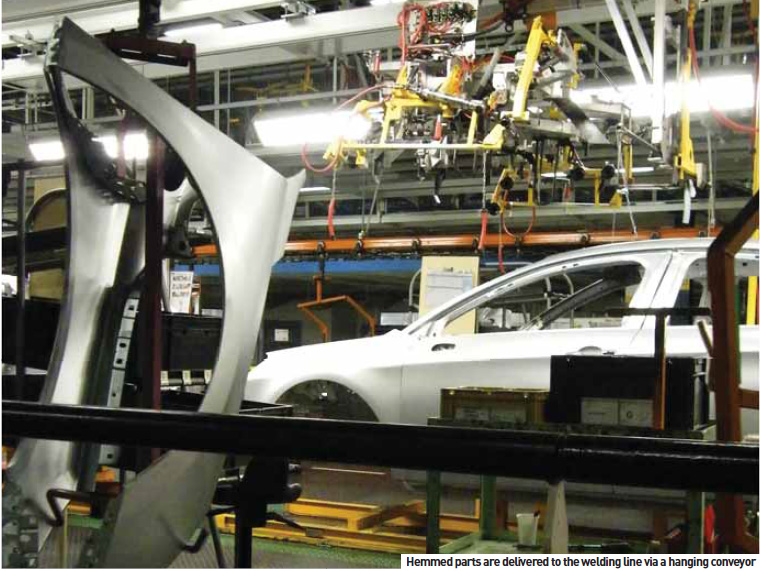
Laser applications
Body-in-white at Rennes is spread over two floors. On the ground floor, parts are subassembled in preparation for floorpan and bodyside assembly, while on the upper level the finished bodies are inspected in advance of delivery to the paintshop, a process which includes hand-finishing of any imperfections.
 Approximately 900 robots, all of which are delivered by Fanuc, are used across the bodyshop. These are largely used to move and position the 430 separate parts and complete the 4,000 to 4,500 spotwelds needed to build a single 508; the difference in weld numbers is dependent on bodystyle. Where manual work is completed, the operator is required to fill in a form in order to certify that each of the required jobs they are obliged to perform have been completed. To assist with this, booklets at each station outline the exact process - and best ergonomic practise - for completing the work, in both words and pictures. When a new team member joins the line, the trainer must fill out a form verifying that the work has been completed to the required standard.
Approximately 900 robots, all of which are delivered by Fanuc, are used across the bodyshop. These are largely used to move and position the 430 separate parts and complete the 4,000 to 4,500 spotwelds needed to build a single 508; the difference in weld numbers is dependent on bodystyle. Where manual work is completed, the operator is required to fill in a form in order to certify that each of the required jobs they are obliged to perform have been completed. To assist with this, booklets at each station outline the exact process - and best ergonomic practise - for completing the work, in both words and pictures. When a new team member joins the line, the trainer must fill out a form verifying that the work has been completed to the required standard.
One of the major installations on the ground floor is where the greenhouse, or ‘pavilion’, is completed with the addition of the roof panel. For this process, a robot fitted with grippers first picks the roof part by the edges and transfers it to a jig. A second robot fitted with suction cups then picks the same part and places it on the car body. In order to secure the roof panel, the part is tacked in place using four spot welds. the roof to the carbody. This is the first time this technique has been used at Rennes and to date, it has only been used for production of the 508. The weld is completed using a bronze filler rod material that creates the join and leaves a seam that can be prepared for painting with very little rework.
Across BIW there are ‘islands’ where individual inner and outer panels are subassembled before being delivered to the welding line via a hanging conveyor. These largely automated cells complete such actions as hemming and clinching fenders and doors. After the closures have been added, body and part alignment is verified in a closed cabin that uses 52 lasers to check more than 500 individual characteristics of each body. These tests also validate panel gap and flush. Taupin: “There’s no exact measurement with regards to gap and flush, but specialists that are trained to know the geometry of the car know what gap is expected at what point. The goal is to keep them the same and to make sure the front and back doors are aligned.”
He further explains that information developed by the laser inspection is sent to a date centre. If a problem is detected, the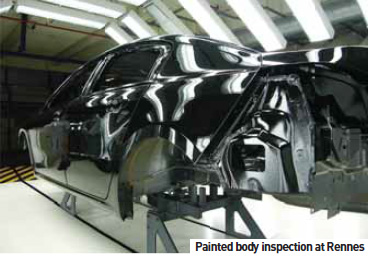 car is isolated in order for the deviation to be corrected. “If we have three cars in succession with the same problem, the line stops and checks are made up stream to determine what’s causing the problem,” he adds.
car is isolated in order for the deviation to be corrected. “If we have three cars in succession with the same problem, the line stops and checks are made up stream to determine what’s causing the problem,” he adds.
BIW management
Across body-in-white, team leaders are responsible for developing a plan to move people around their respective line areas. This means that while staff workers must be trained to do a number of jobs, it serves to motivate and reduce boredom, while also minimising the chance of repetitive strain and other related illnesses, while also covering for absenteeism. “The average age of the working population at the plant is 46 years and the average time a worker is employed at the plant is 23 years,” says Taupin. “Around the group, Rennes is recognized as having the workforce with the highest skill level, which is why it was selected to build the 508 and C5, the premium products in the PSA range.”
Paintshop hardware
In addition to the standard paintshop processes, production of the 508 has been enhanced with the addition of a new automated station within the paintshop where acoustic panels are added to the carbody. Stéphane Gélas, Director of the Paintshop, offers further details: “In the past we had to manually apply the pads to the chassis in order to reduce sound and vibration. We have replaced this by using sprayed material. [With the system] you can decide to reduce weight and have the same acoustic performance, or have the same weight and improve acoustic performance. The new system is a balance between weight and performance.”
 The new pads are made up of an epoxy that creates an acoustic PVC material which is applied to key areas of the chassis. While ‘spray’ is a convenient descriptive for the application process, it is inaccurate, as Gélas explains. “When you spray materials, you have overspray and waste, it’s a quality risk.” Essentially, rather than a spray, the material is applied directly to the carbody. It has taken four years to plan, test and implement the new process, but Gélas - who has been involved with paintshop engineering and management for 21 years - says that he is more than happy with the results. “It’s an area where labour is happy to have this automation. The ergonomics behind manual application [of the sound pads] is a nightmare. The production and engineering teams are very happy, and it reduces weight and noise.”
The new pads are made up of an epoxy that creates an acoustic PVC material which is applied to key areas of the chassis. While ‘spray’ is a convenient descriptive for the application process, it is inaccurate, as Gélas explains. “When you spray materials, you have overspray and waste, it’s a quality risk.” Essentially, rather than a spray, the material is applied directly to the carbody. It has taken four years to plan, test and implement the new process, but Gélas - who has been involved with paintshop engineering and management for 21 years - says that he is more than happy with the results. “It’s an area where labour is happy to have this automation. The ergonomics behind manual application [of the sound pads] is a nightmare. The production and engineering teams are very happy, and it reduces weight and noise.”
He goes on to say that using the new SCA system - which he believes is similar to a system used at Jaguar - has delivered a weight saving of approximately 1kg per car. “At the same time you have a weight reduction you’re using less product, which is not so easy to achieve. Of course, you can achieve weight reductions using aluminium, for example, but this increases the cost. When you achieve weight reduction and cost reduction, that is something special.” The 508 has replaced both the 407 and 607 ranges. Gélas says that the 607 was a very good car in terms of acoustics, but this came with a weight penalty. He estimates that between 10 and 15kg of total vehicle weight could be attributed to sound damping material. “You want to reduce the weight in order to reduce CO2 and improve fuel economy. But the customer should not be aware of the efforts made by the OEM to achieve perfect resonance, this should be an unknown application.”
Paint solutions
Gélas says that the paint shop at Rennes dates back to the 1980s. Although it was put in place by a company that has since been acquired by Dürr, it does not incorporate systems such as RoDip in the line. Is this something that would be considered for future development? “This paint line is perfect,” says Gélas. “We have to be careful with European investment. I don’t think that we could ever recoup the investment required to change the plant. We have been investing over the last 15 years to optimise quality, every detail is optimised.”
With regards to energy savings, he says that while there will be additional investments made to improve energy recovery, specific investment has been made to address the catalytic treatment of VOCs. “I think that every European plant wants to reduce the amount of energy used, but it’s not a specific point at Rennes; we don’t have that kind of investment schedule. For the pre-treatment and cathodic electrolytic dip, we won’t change anything.” As for adding chassis sealants, Gélas points out that this is a process that combines automated and manual processes. He continues by saying that a combined approach to application of the PVC-based material can achieve a better level of quality. Where the material is applied automatically, machinery is fitted with cameras in order to identify special holes in the chassis through which the material is added. A vision system also confirms the positioning of the carbody, the robotics adapting to minor deviations. For the exterior application, the material is applied in a swirl, which Gélas says delivers important weight savings and a ‘very good’ sealing function.
Paint products, which are supplied by BASF, are applied to both the 508 and C5 on the same line, which starts with a water-borne primer. Top coat and base coat layers are then added, after which a clearcoat layer is applied. For this, a new product is about to be introduced. “Today we’re using a classical clearcoat chemistry, but we are about to introduce a third-generation product.” Supplied by Bollig & Kemper, the new clearcoat is designed to both improve the look of finished cars and also resist weathering. “Each time you change the model you have to target improved appearance and this was one of our goals with the 508,” says Gélas. “It’s not unique, but it was developed with the 508 in mind.” In terms of delivery this will be a traditional clearcoat product, applied as a liquid rather than a powder or slurry, but it has characteristics that will support a better finish over the lifetime of the car. While car wash brushes and acid rain can deteriorate a clearcoat, this product will resist these attacks while also protecting the underlying paint finish. Other paintshop technologies have been tested at Rennes, with varying degrees of success. At one point, a high pressure, low volume system was put in place to remove dust and other particles from the carbodies in preparation for paint. Although this was a clean system, it was very inefficient, which prompted the move back to using standard ostrich feathers. “We replace them about one a year,” says Gélas.
Colour application
The paint line at Rennes, which is mostly automated, also has 10 workers finishing base coat applications and five workers in the clearcoat booth. The clearcoat is applied using a RoboBell system, which Gélas describes as a classic bell application with high voltage and high-speed atomization.
Speaking about vehicle batching, he says that the optimum number of cars of one colour is three, but this is an ideal rather than a fixed number. “We have to have a balance. We build to order and we don’t want the customer to wait to long, but we also have to be efficient. For the robots, this isn’t such a big problem, the colour source is very close to the bell applicators. For the guys on the line, they have to change the gun, clean with compressed air, so if we can complete three cars, it’s a good balance between quality, efficiency and there’s not too much wastage.”
For the 508, standard paint products are applied using a typical bell system. For metallics, a bell gun method is used. “If

you only have high-voltage applications, the aluminium flake in the [metallic] paint can be badly oriented - you can see it in the finish,” says Gélas. Further to this, there are plans to add other non-standard paints. “The C5 is already available with a matte black finish and we’re thinking about adding this option for the 508.” He points out that while 95% of light is reflected from a standard paint surface, a matte paint can reflect as little as 20%. “For the C5 our choice was to go a bit higher, about 27% gloss. For the [Citroën] DS3, we use a 15% matte.”
Gélas reports that over one six-month period the paintshop had three days with zero defects, but on average the paintshop at Rennes returns a low 0.4% defect rate - this translates to between 10 and 20 cars per day that need further work. This equates to about 5% of daily production; 4% require touch up work and 1% needing a full repaint.
Feeding the line
In the assembly hall, Loïc Taupin explains that the overall setup has a fast line - the main assembly line - and a series of slower lines that feed in modules and subassemblies. Examples of this setup include delivery of full powertrain assemblies to the marriage station, as well as instrument panels, panoramic sunroofs and kitted doors. The main line is supplied from a central part supermarket that is located next to the trim line. Every hour 30 trains, each comprising five or six carts, leave this area in order to deliver components to the line. Instead of the line operators calling for resupply, the delivered part quantity is sufficient for a pre-determined run of production; scheduled resupply is based on units delivered and takt time, which Taupin says is now 77 seconds.
The assembly line is made up of approximately 300 stations, each of which is between five and six metres in length, just sufficient to accommodate a car. Instead of using a numerical system, stops on the line are named using different types of fruit, which is far more memorable. Within the fruit demarcations, a system of grey boxes highlights which cart is carrying contents for that station. Instead of lining up parts, which would require an inordinate amount of space, items such as headlights are preloaded into custom-made trollies which when picked in order deliver the right part just in sequence with assembly line production. “Three trollies of headlights are delivered at a time, with 12 units in each,” says Taupin. “This represents about 45 minutes of work.”
Supermarket sweep
About 300 trucks deliver parts to PSA Rennes each day. In order to accommodate this quantity of inbound stock, each truck is given an assigned dock time. In total, the plant receives approximately 55,000 parts per day which must be distributed across the supermarket in preparation for delivery to the line. To improve stocking and loading efficiency, the supermarket largely reflects the layout of the assembly line. Once unloaded, dunnage is scanned in order to alert suppliers what has arrived and what containers will be returned; boxes that need to be cleaned are directed to a dedicated washing area. Overall, the system has reduced wastage by 300%.
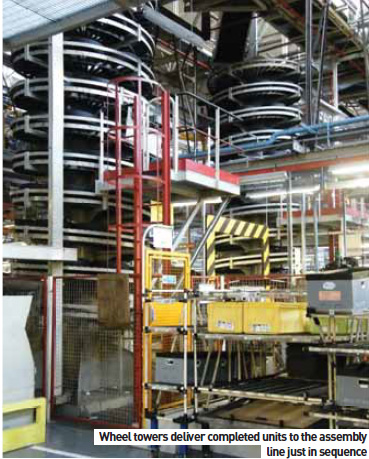 According to Taupin, each car incorporates about 3,000 individual parts. Once these have been assembled, the sum total of a day’s output averages 950 508 and C5 cars (approximately 45 cars per hour), which are shipped out using 100 road transporters and 100 train trucks. Each finished vehicle is passed through a standard series of tests, including on-board system, engine and water ingress. Further to this, about 45 cars each day are picked at random to be taken out onto the test track where road holding and acoustic performance is evaluated. “There are two people on the test drive, the driver and an acoustic specialist,” says Taupin. “Training for acoustic specialists can take up to six months. They sit in the back and listen to the car. A well-trained specialist can say exactly where a noise is coming from and whether it’s supposed to be there or not. You can sit with them and you’d say ‘there’s no noise’, and they’ll say ‘actually there’s noise coming from there and there’.”
According to Taupin, each car incorporates about 3,000 individual parts. Once these have been assembled, the sum total of a day’s output averages 950 508 and C5 cars (approximately 45 cars per hour), which are shipped out using 100 road transporters and 100 train trucks. Each finished vehicle is passed through a standard series of tests, including on-board system, engine and water ingress. Further to this, about 45 cars each day are picked at random to be taken out onto the test track where road holding and acoustic performance is evaluated. “There are two people on the test drive, the driver and an acoustic specialist,” says Taupin. “Training for acoustic specialists can take up to six months. They sit in the back and listen to the car. A well-trained specialist can say exactly where a noise is coming from and whether it’s supposed to be there or not. You can sit with them and you’d say ‘there’s no noise’, and they’ll say ‘actually there’s noise coming from there and there’.”
Over its 50-year history, PSA and the employees at Rennes have condensed automotive production not into a single science, but into a series of disciplines that come together to deliver a finished vehicle using highly-efficient processes. The Peugeot 508 is a remarkable step forward for the company that is sure to serve it well while it remains in production. As for the future, the model will undoubtedly be used as a benchmark for quality in production.
































